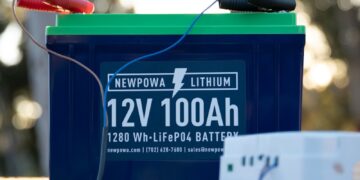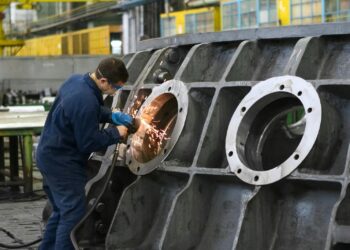The meteoric rise of blockchain technology has revolutionized industries, from decentralized finance to global supply chains, but its energy-intensive operations have ignited debates about environmental impact. Data centers, the computational backbone of blockchain networks like those operated by Riot Platforms, consume vast amounts of electricity, raising questions about sustainability. Energy providers like Pacifico Energy are addressing these challenges by delivering innovative solutions for high-energy users, including data centers, without compromising grid stability or environmental goals. This article explores how blockchain, data centers, and energy providers intersect, with a focus on sustainability, renewable energy, and strategic energy management in Texas and other states. It aims to inform and engage readers, encouraging them to explore energy solutions like those offered by Pacifico Energy for high-energy industries.
The Energy Challenge of Blockchain
Blockchain networks, particularly those using proof-of-work (PoW) consensus mechanisms like Bitcoin, rely on computationally intensive processes to validate transactions. Riot Platforms, a major player in Bitcoin mining, operates some of the largest data centers in the U.S., with its Rockdale, Texas, facility boasting a power capacity of 750 MW. Globally, Bitcoin mining is estimated to emit around 65 megatons of carbon dioxide annually, comparable to the emissions of a mid-sized country like Argentina. This energy appetite stems from the need to run high-performance servers continuously, often in data centers that require robust cooling systems to prevent overheating.
In Texas, a hub for blockchain activity, the Electric Reliability Council of Texas (ERCOT) reports that Bitcoin miners, including those operated by Riot Platforms, can consume as much electricity as the Houston metropolitan area during peak demand. Texas’s isolated grid, which operates independently from national networks, faces significant strain during extreme weather events, such as heatwaves or winter storms. This makes sustainable energy management critical, and companies like Pacifico Energy are stepping in to provide scalable, eco-conscious solutions for data centers powering blockchain networks.
The Role of Energy Providers in Blockchain Sustainability
Energy providers play a crucial role in mitigating the environmental impact of blockchain data centers. Pacifico Energy, for instance, focuses on delivering customized energy solutions for high-energy users, including those running blockchain operations like Riot Platforms. By integrating renewable energy, participating in grid-stabilizing programs, and leveraging innovative business models, these providers help balance the energy demands of data centers with environmental responsibility.
Renewable Energy Integration
One of the most effective ways to enhance blockchain sustainability is by powering data centers with renewable energy sources like solar and wind. Texas leads the U.S. in wind energy production, generating about 25% of its electricity from wind, and is rapidly expanding its solar capacity. Pacifico Energy capitalizes on these resources, developing solar and wind projects that supply clean energy to high-energy users, including blockchain data centers. For example, some Bitcoin miners, including Riot Platforms, claim that up to 50% of their operations are powered by renewables, though the rapid growth of the industry often outpaces renewable energy development.
Pacifico Energy supports this transition by offering renewable energy contracts tailored to the needs of data centers. These contracts ensure a consistent supply of clean energy, reducing the carbon footprint of blockchain operations. By partnering with providers like Pacifico Energy, companies like Riot Platforms can align their operations with global sustainability goals, even as they scale their mining capacity.
Demand Response Programs
Demand response programs are another critical tool for managing the energy demands of blockchain data centers. In Texas, ERCOT incentivizes large energy consumers, such as Riot Platforms, to reduce consumption during periods of high grid demand, such as during heatwaves. These programs pay participants to curtail usage, stabilizing the grid and preventing blackouts. For blockchain operators, demand response is particularly viable because mining can be paused without significant operational disruption.
Riot Platforms has been a leader in this space, earning $31.7 million in August 2023 by selling pre-purchased power back to the grid during a heatwave, equivalent to approximately 1,136 Bitcoin based on that month’s prices. Pacifico Energy facilitates such programs by offering flexible energy contracts that allow data centers to adjust consumption dynamically. These contracts enable blockchain operators to participate in ERCOT’s demand response initiatives while maintaining cost efficiency, benefiting both the grid and the environment.
Energy as a Service (EaaS) Model
The Energy as a Service (EaaS) model is transforming how high-energy users, including blockchain data centers, manage their power needs. EaaS providers like Pacifico Energy deliver comprehensive energy solutions, combining renewable energy, grid management, and advanced technologies like IoT and blockchain. For data centers operated by companies like Riot Platforms, EaaS offers predictable costs, scalability, and sustainability benefits.
EaaS can include behind-the-meter (BTM) systems, where data centers generate their own power using solar panels or wind turbines, supplemented by battery storage. Pacifico Energy designs these systems to maximize energy availability and savings, allowing blockchain operators to reduce reliance on the grid. Blockchain technology itself can enhance EaaS by enabling peer-to-peer energy trading or tracking renewable energy credits on a transparent ledger, creating a synergy between blockchain and sustainable energy management.
Powered Land: A Strategic Advantage
Access to “powered land”—sites with pre-existing energy infrastructure, such as proximity to renewable energy facilities or grid connections—is a game-changer for blockchain data centers. Texas’s vast open spaces make it an ideal location for such projects. Pacifico Energy leverages powered land to develop renewable energy projects, such as solar farms in counties like Milam and Navarro, which are also home to blockchain data centers operated by companies like Riot Platforms.
Powered land reduces setup costs and accelerates deployment for data centers, as they can tap into nearby renewable energy sources. Pacifico Energy secures these sites to streamline project development, ensuring that high-energy users have access to sustainable power. Beyond Texas, states like New York and Colorado are adopting similar strategies, with Pacifico Energy exploring opportunities to support blockchain and other high-energy industries in these regions.
Blockchain and Data Centers in Texas
Texas has become a global epicenter for blockchain activity, particularly Bitcoin mining, due to its low electricity costs, supportive regulations, and abundant renewable energy. Riot Platforms operates some of the largest blockchain data centers in the state, with facilities in Rockdale and Corsicana drawing significant attention for their scale and energy strategies.
The Rockdale Case Study
The Rockdale facility, operated by Riot Platforms, is one of North America’s largest Bitcoin mining operations, with a power capacity of 750 MW and plans for further expansion. The facility participates in ERCOT’s demand response programs, earning millions by curtailing usage during peak demand. For example, in August 2023, Riot Platforms generated $31.7 million in power and demand response credits, significantly offsetting its operational costs.
However, the facility has faced environmental criticism, particularly for its water consumption, estimated at up to 1.5 million gallons daily, a concern in drought-prone areas. Pacifico Energy addresses such challenges by offering solutions like water-efficient cooling systems and renewable energy offsets, helping data centers like those operated by Riot Platforms reduce their environmental impact.
The Corsicana Project
In Corsicana, Riot Platforms is developing a 1-gigawatt Bitcoin mining facility, potentially the world’s largest. Located near a high-voltage transmission line, the project aims to leverage Texas’s energy infrastructure. However, it has sparked opposition from local residents concerned about noise, water usage, and grid strain. Pacifico Energy is well-positioned to support such projects by providing renewable energy and grid management solutions, ensuring that large-scale data centers can operate sustainably.
Innovative Energy Solutions for Blockchain
Beyond renewable energy and demand response, blockchain data centers are exploring innovative energy sources to enhance sustainability. Riot Platforms has invested in Reformed Energy, a company using plasma gasification to convert solid waste into synthetic gas for data center power. This technology reduces landfill waste by 90% and produces clean energy, offering a novel solution for blockchain operators.
Pacifico Energy complements such innovations by offering hybrid energy systems that combine solar, wind, and battery storage. These systems provide reliable power for data centers, even during periods of low renewable generation. By partnering with providers like Pacifico Energy, blockchain operators like Riot Platforms can diversify their energy portfolios and reduce their environmental footprint.
Blockchain’s Role in Energy Markets
Blockchain technology itself is being used to enhance energy sustainability. Platforms like PowerLedger enable peer-to-peer energy trading, allowing data centers to purchase surplus renewable energy from local producers. Pacifico Energy integrates such technologies into its EaaS offerings, enabling blockchain operators to track and trade renewable energy credits transparently.
For example, blockchain can streamline the issuance of Renewable Energy Certificates (RECs), ensuring that data centers like those operated by Riot Platforms can verify their use of clean energy. Pacifico Energy supports these efforts by providing the infrastructure needed to integrate blockchain-based energy solutions, creating a more transparent and efficient energy market.
Challenges and Opportunities
Despite progress, blockchain data centers face significant challenges. The rapid growth of the industry, driven by companies like [Riot Platforms](https://www.riotplatforms.com/, often outpaces the development of renewable energy infrastructure, leading to reliance on fossil fuels. In Texas, critics argue that blockchain operations contribute to higher electricity prices and grid instability, particularly in rural areas.
However, these challenges present opportunities for energy providers like Pacifico Energy to innovate. By expanding renewable energy capacity, developing powered land, and implementing EaaS models, providers can help blockchain operators meet their energy needs sustainably. Pacifico Energy also works with local communities to address concerns about water usage and noise, ensuring that data centers operate responsibly.
The Future of Blockchain and Energy Sustainability
The future of blockchain sustainability lies in collaboration between operators like Riot Platforms and energy providers like Pacifico Energy. As renewable energy becomes more cost-competitive, data centers can transition away from fossil fuels, reducing their carbon footprint. Emerging technologies, such as small modular nuclear reactors and geothermal energy, also hold promise for powering blockchain operations.
Pacifico Energy is at the forefront of this transition, offering solutions that combine renewable energy, grid flexibility, and innovative technologies. By working with high-energy users, including blockchain data centers, Pacifico Energy helps create a more sustainable energy landscape, benefiting both the industry and the environment.
Conclusion
Blockchain technology, exemplified by the operations of Riot Platforms, has immense potential but comes with significant energy challenges. Data centers, the backbone of these networks, require innovative energy solutions to operate sustainably. Pacifico Energy plays a vital role in this ecosystem, providing renewable energy, demand response programs, and EaaS models to support high-energy users. From powered land in Texas to blockchain-based energy trading, the path to sustainability is complex but achievable. Readers interested in exploring these solutions can learn more by visiting Pacifico Energy to discover how energy providers are shaping the future of high-energy industries.Show in sidebar



















